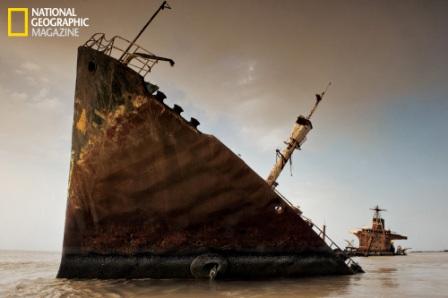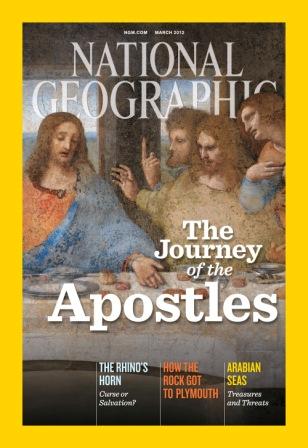
©Thomas P. Peschak/National Geographic, "A relic of the Iran-Iraq war, this oil tanker was scuttled near the Kuwait-Iraq border on Saddam Hussein's orders, to block access by sea to southern Iraq. Kuwaiti authorities are reluctant to remove the vessel for fear of damaging the wetlands of nearby Bubiyan Island, an important fish nursery and seabird breeding ground." (This photo is in the March 2012 issue of National Geographic magazine on newsstands February 28.)
As part of doing a write up on the The Seas of Arabia article, National Geographic gave me the chance to ask writer Kennedy Warne a few questions and I jumped at the opportunity because I wanted to know more about what happened behind the scenes as he was gathering information for the article. Well, it turns out that the questions I asked were more appropriate for photographer Thomas Peschak, since he pitched the story idea and took all the photos. Sounds great I thought, his photos are amazing.
And then I waited to hear back and waited. I chalked up the delay to another busy person juggling a million things, someone who just didn’t have time to deal with one more task. Then yesterday morning I received an email from National Geographic’s PR department, it turns out that Thomas was delayed in getting back to me because he was dealing with…a cyclone!
I’ve heard a lot of reasons why people are running late, but this is my first cyclone excuse. Then I thought, the staff at National Geographic has probably heard some really interesting tales and maybe dealing with a cyclone is something they get all the time. I wrote back and asked, “So glad to hear that Thomas is okay! Wow, a cyclone…is that something you hear a lot from National Geographic photographers?!”
Megan Heltzel, who works in National Geographic’s Communications department, wrote back, “I have to say, that was a first for me. I have heard some crazy things, but never a cyclone! With the extreme locations that our photographers and writers travel to there are always these risks. Thankfully he was OK!”
I agree, thankfully Thomas was okay! And after surviving a cyclone he even found time to answer my questions, which was extremely nice of him. Make sure you check out his photo gallery on National Geographic’s website and read The Seas of Arabia article in the March 2012 edition of National Geographic. Thomas Peschak is truly a gifted photojounalist, his photos capture the mixture of beauty and trouble that is the Arabian Seas. His image of a pharaoh cuttlefish caught on camera moments before its death will haunt me for a long time.
Q. Why did you decide to write about the Arabian Seas?
A. As a marine photojournalist I am always on the lookout for new and revealing stories about our planet’s ocean realms. Most people only associate Arabia with sand, camels and oil, but this region also harbors an incredible marine biodiversity, a fact known to only a very few insiders. My aim with this article was to showcase the often overlooked and forgotten marine wonders of Arabia’s seas to a global audience.
Q. The article discusses the challenges facing marine life in the region, yet there are many amazing wildlife photos. Was it tough finding animals to capture on camera?
A. Diving and marine exploration is still in its infancy at many of the locations that I visited for this story, so often I had to rely on scientists and fishermen to show me the best locations for the different species that I was trying to photograph. Without them many of the images in this story would not have become reality.
Q. Overall, how do you feel about the region’s future?
A. I think that the fate of Arabia’s marine biodiversity will be decided in the coming decade. If the intensity of coastal development does not abate and the use of gill nets and other destructive and unsustainable fishing practices continues then I fear it’s future is bleak. However if the voices of Arabia’s marine conservationists are heeded and they receive both local and international support, then I have high hopes for this fragile yet resilient marine eco-region.

What a coup. Well done, OWT!